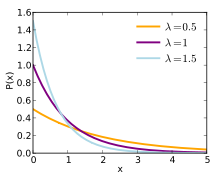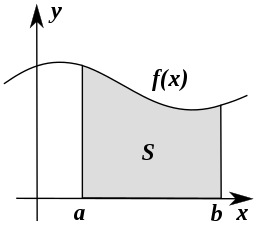Probability density function
A probability density function, often called density function, probability density, distribution density, or just density for short, and abbreviated WDF or English pdf from probability density function, is a special real-valued function in stochastics, a branch of mathematics. There, the probability density functions are used for the construction of probability distributions using integrals as well as for the investigation and classification of probability distributions.
Unlike probabilities, probability density functions can also take values above one. The construction of probability distributions over probability density functions is based on the idea that the area between the probability density function and the x-axis from a point 



In a more general context, probability density functions are density functions (in the sense of measure theory) with respect to the Lebesgue measure.
While in the discrete case probabilities of events can be calculated by summing up the probabilities of the individual elementary events (for example, an ideal cube shows each number with a probability of 
The probability that a random variable takes a value between 



Definition
Probability densities can be defined in two ways: once as a function from which a probability distribution can be constructed, the other time as a function derived from a probability distribution. The difference, then, is the direction of approach.
On the construction of probability measures
Given a real function

is nonnegative, that is,
for all
.
is integrable.
is normalized in the sense that

Then 
a probability distribution on the real numbers.
Derived from probability measures
Given a probability distribution 

If there exists a real function 
respectively
holds, then 


Examples
A probability distribution that can be defined by a probability density function is the exponential distribution. It has the probability density function
Here, λ 




A probability distribution from which a probability density function can be derived is the continuous uniform distribution on the interval ![[0,1]](https://www.alegsaonline.com/image/738f7d23bb2d9642bab520020873cccbef49768d.svg)
![{\displaystyle P([a,b])=b-a}](https://www.alegsaonline.com/image/6052c0e18e49b3f8c4e3b8b4202077ef3688ccc7.svg)

Outside the interval all events get the probability zero. We are now looking for a function 
holds if ![{\displaystyle a,b\in [0,1]}](https://www.alegsaonline.com/image/60ee2939f5ce032e8c7851830c3e89f6eee99c7e.svg)
satisfies this. It is then continued outside the interval ![[0,1]](https://www.alegsaonline.com/image/738f7d23bb2d9642bab520020873cccbef49768d.svg)
Similarly, the probability density function would be
possible, since both differ only on a Lebesgue null set and both satisfy the requirements. One could create any number of probability density functions just by modifying the value at a point. In fact, this does not change the property of the function being a probability density function, since the integral ignores these small modifications.
For more examples of probability densities, see the list of univariate probability distributions.

Probability density functions of the exponential distribution for different parameters.
Questions and Answers
Q: What is a probability density function?
A: A probability density function is a function that characterizes any continuous probability distribution.
Q: How is the probability density function of a random variable X written?
A: The probability density function of X is sometimes written as f_X(x).
Q: What does the integral of the probability density function represent?
A: The integral of the probability density function represents the probability that a given random variable with the given density is contained in an interval provided.
Q: Is the probability density function always non-negative throughout its domain?
A: Yes, by definition, the probability density function is non-negative throughout its domain.
Q: Does integrating over an interval sum up to 1?
A: Yes, integrating over an interval sums up to 1.
Q: What type of distribution does a Probability Density Function characterize?
A: A Probability Density Function characterizes any continuous probability distribution.
Search within the encyclopedia


![{\displaystyle P([a,b]):=\int _{a}^{b}f(x)\,\mathrm {d} x}](https://www.alegsaonline.com/image/bc8420a5e0d9d51abcba931f5e011e6e8f364419.svg)

![{\displaystyle P((-\infty ,a])=\int _{-\infty }^{a}f(x)\,\mathrm {d} x}](https://www.alegsaonline.com/image/48fb41cb1600798fcbb82405eed24043e171b94a.svg)


![{\displaystyle \int _{a}^{b}f(x)\,\mathrm {d} x=P([a,b])=b-a}](https://www.alegsaonline.com/image/b2930c09ea9d8790b88d49b01e408265fb8468d7.svg)

![{\displaystyle f(x)={\begin{cases}\displaystyle 1&{\text{ falls }}x\in [0,1]\\0&{\text{ sonst }}\end{cases}}}](https://www.alegsaonline.com/image/7794ae707a329efb8b2e59a7d5a515020e943ce7.svg)
